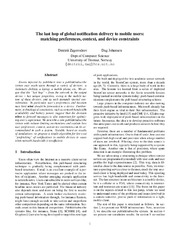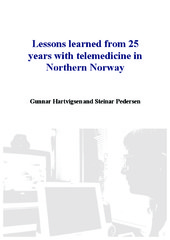Blar i tittel Institutt for informatikk
Viser treff 303-322 av 625
-
K-CUSUM: Cluster Detection Mechanism in EDMON
(Journal article; Tidsskriftartikkel; Peer reviewed, 2019-11)The main goal of the EDMON (Electronic Disease Monitoring Network) project is to detect the spread of contagious diseases at the earliest possible moment, and potentially before people know that they have been infected. The results shall be visualized on real-time maps as well as presented in digital communication. In this paper, a hybrid of K-nearness Neighbor (KNN) and cumulative sum (CUSUM), known ... -
Keeping Up with the Market: Extracting competencies from Norwegian job listings
(Mastergradsoppgave; Master thesis, 2021-05-15)The Norwegian labour market is under continuous change because of fast-paced innovation in technology. It is therefore vital for educational institutions curricula to reflect the changing requirements to keep the population hireable and provide employers with a highly adaptable workforce. There are no complete systems that let us analyse and extract this information about the labour market efficiently. ... -
Kontekstsensitiv tilpasning av interaksjonsmodi mot mobile terminaler
(Master thesis; Mastergradsoppgave, 2003-12-15)Denne oppgaven ser på mulighetene for å bruke kontekstinformasjon for å kunne tilpasse interaksjonsmodi mot mobile terminaler, spesielt mobiltelefoner. Hensikten er å illustrere hvordan brukere av et transportselskap automatisk kan motta beskjeder om forsinkelser på bussavganger han/hun er interessert i, samt andre beskjeder fra transportselskapet. Brukere skal altså slippe å kjenne til vanlige ... -
Kvasir-SEG: A Segmented Polyp Dataset
(Journal article; Tidsskriftartikkel; Peer reviewed, 2020-01-24)Pixel-wise image segmentation is a highly demanding task in medical-image analysis. In practice, it is difficult to find annotated medical images with corresponding segmentation masks. In this paper, we present Kvasir-SEG: an open-access dataset of gastrointestinal polyp images and corresponding segmentation masks, manually annotated by a medical doctor and then verified by an experienced ... -
Kvik : interactive exploration of genomic data from the NOWAC postgenome biobank
(Master thesis; Mastergradsoppgave, 2014-05-15)Recent technological advances provide large amounts of data for epidemiological analyses that can provide novel insights in the dynamics of carcinogenesis. These analyses are often performed without prior hypothesis and therefore require an exploratory approach. Realizing exploratory analysis requires the development of new systems that provide interactive exploration and visualization of large-scale ... -
Kvik: three-tier data exploration tools for flexible analysis of genomic data in epidemiological studies
(Journal article; Tidsskriftartikkel; Peer reviewed, 2015-03-30)Kvik is an open-source system that we developed for explorative analysis of functional genomics data from large epidemiological studies. Creating such studies requires a significant amount of time and resources. It is therefore usual to reuse the data from one study for several research projects. Often each project requires implementing new analysis code, integration with specific knowledge bases, ... -
Kvik: three-tier data exploration tools for flexible analysis of genomic data in epidemiological studies [version 1; peer review: 2 approved with reservations]
(Journal article; Tidsskriftartikkel; Peer reviewed, 2015-03-30)Kvik is an open-source system that we developed for explorative analysis of functional genomics data from large epidemiological studies. Creating such studies requires a significant amount of time and resources. It is therefore usual to reuse the data from one study for several research projects. Often each project requires implementing new analysis code, integration with specific knowledge bases, ... -
Label-free non-invasive classification of rice seeds using optical coherence tomography assisted with deep neural network
(Journal article; Tidsskriftartikkel; Peer reviewed, 2021-01-01)Identification of the seed varieties is essential in the quality control and high yield crop growth. The existing methods of varietal identification rely primarily on visual examination and DNA fingerprinting. Although the pattern of DNA fingerprinting allows precise classification of seed varieties but fraught with challenges such as low rate of polymorphism amongst closely related species, destructive ... -
Large Multiples : exploring the large-scale scattergun approach to visualization and analysis
(Master thesis; Mastergradsoppgave, 2014-05-15)We create 2.5 quintillion bytes of data every day. A whole 90% of the world’s data was created in the last two years.1 One contribution to this massive bulk of data is Twitter: Twitter users create 500 million tweets a day,2 which fact has greatly impacted social science [24] and journalism [39]. Network analysis is important in social science [6], but with so much data there is a real danger of ... -
The last hop of global notification delivery to mobile users. Matching preferences, context, and device constraints.
(Research report; Forskningsrapport, 2004)Events injected by publishers into a publish/subscribe system may reach users through a variety of devices: a stationary desktop, a laptop, a mobile phone, etc. We argue that the "last hop" -- from the network to the output device -- has unique properties, owing to the mobile nature of these devices, and as such demands special consideration. In particular, user's preferences and location may limit ... -
Latency Optimized Microservice Architecture for Privacy Preserving Computing
(Master thesis; Mastergradsoppgave, 2019-06-01)Recent developments in microservices architecture and building have lead to the advent of unikernels, a specialized operating system kernel coupled with, and executing only, a single application. This thesis presents PPCE a distributed system utilising a microservices architecture based on unikernels, created to enable privacy-preserving computing for users, classes of users, and more importantly; ... -
Láhttu-A system for Retrieval and Consolidation of Personsal Data from Activity-Tracking Web Services.
(Master thesis; Mastergradsoppgave, 2014-06-01)In recent years, self-tracking and recording ourself has become increasingly popular. A large ecosystem of interconnected online activity-tracking web services that record, store, analyse, and visualize personal data is evolving to provide useful services to end-users. However, these personal data can be scattered over multiple web-services, which makes it difficult for an individual to manage and ... -
Lessons learned from 25 years with telemedicine in Northern Norway
(Book; Bok, 2015) -
Leveraging Mobile UX Principles for Nudges In Green Transportation
(Master thesis; Mastergradsoppgave, 2020-08-17)Smart nudging has a goal to try to nudge users, these nudges are personally tailored for their specific situation and needs. In this thesis we will combine knowledge from Nudging and principles from user interface design and user experience research to increase the likelihood of the smart nudges to be as effective as possible. -
LightLayers: Parameter Efficient Dense and Convolutional Layers for Image Classification
(Chapter; Bokkapittel, 2021-02-21)Deep Neural Networks (DNNs) have become the de-facto standard in computer vision, as well as in many other pattern recognition tasks. A key drawback of DNNs is that the training phase can be very computationally expensive. Organizations or individuals that cannot afford purchasing state-of-the-art hardware or tapping into cloud hosted infrastructures may face a long waiting time before the training ... -
Limelight: Real-Time Detection of Pump-and-Dump Events on Cryptocurrency Exchanges Using Deep Learning
(Master thesis; Mastergradsoppgave, 2019-06-01)Following the birth of cryptocurrencies back in 2008, internet investment platforms called exchanges were created to constellate these cryptocurrencies. Allowing investors to sell and buy assets equitable and agile over a single interface. Exchanges now have become popular and carry out over 99% of all daily transactions, totaling hundreds of millions of dollars. Despite that exchanges handling ... -
Local-First Relation Views
(Mastergradsoppgave; Master thesis, 2023-06-01)In today's digital landscape where cloud-oriented approaches are widespread and an integral part, local-first software emerges to offer an alternative. It addresses concerns such as data control, privacy, offline capabilities, collaboration, and performance. The open-source relational database engine SQLite is a fitting candidate for local-first software as it is not reliant on network connectivity. ... -
Long-Term Engagement With a Mobile Self-Management System for People With Type 2 Diabetes
(Journal article; Tidsskriftartikkel; Peer reviewed, 2013-03-27) -
The Longcut Wide Area Network Emulator. Design and Evaluation
(Research report; Forskningsrapport, 2005)Experiments run on a Grid, consisting of clusters administered by multiple organizations connected by shared wide area networks (WANs), may not be reproducible. First, traffic on the WAN cannot be controlled. Second, allocating the same resources for subsequent experiments can be difficult. Longcut solves both problems by splitting a single cluster into several parts, and for each part having one ... -
Low-Cost Programmable Air Quality Sensor Kits in Science Education
(Chapter; Bokkapittel, 2018-02-21)We describe our citizen science approach and technologies designed to introduce students in upper secondary schools to computational thinking and engineering. Using an Arduino microcontroller and low-cost sensors we have developed the air:bit, a programmable sensor kit that students build and program to collect air quality data. In our course, students develop their own research questions regarding ...


 English
English norsk
norsk


















